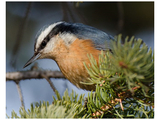And how citizens can contribute to science
This article was first published here and was written by Sarah Hansen.
The charismatic Red-breasted Nuthatch usually makes its home in Canadian forests, but this year it’s been spotted in large numbers as far south as Maryland. This phenomenon, known as an irruption, is well known in ornithology, but not well understood. In The Conversation, UMBC’s Sarah Luttrell and Archer Larned, Ph.D. candidates in biological sciences, describe the factors scientists believe may cause irruptions, and why citizen scientists are so important to learning more.
Irruptions often follow a boom-and-bust cycle of food sources, Luttrell and Larned explain. In a phenomenon known as masting, a tree species may produce a larger than normal number of seeds across thousands of miles of its range. That abundance increases the prosperity of birds that rely on the tree’s seeds for food. Come winter, “the bird population has doubled, or even tripled, but the available habitat hasn’t,” Luttrell and Larned say, so the “extra” birds travel farther than usual away from their normal winter range, bringing birds like red-breasted nuthatches to the mid-Atlantic.
The cause of masting isn’t well understood, but it appears to be triggered by warm, dry weather in spring. Climate change may affect the frequency of masting events, and tracking irruptions may help scientists understand how climate change is affecting forest health.
While masting events may occur every few years, some food explosions happen on a longer timescale. For example, the spruce budworm emerges approximately every 20 years. “While budworms decimate spruce trees, birds gorge themselves on budworms,” causing a population boom that can lead to irruption. In response to a lemming population boom, Snowy Owls irrupted as far south as the Bahamas in 2013 – 2014.
Masting and irruptions are hard to predict, so the scientific community relies on citizen scientists to collect data about bird numbers and locations. “Citizen scientists are a crucial asset for studying irruptions,” write Luttrell and Larned.
By contributing to online databases such as Project FeederWatch, Christmas Bird Count, eBird, and Great Backyard Bird Count, “Novice and expert bird-watchers across large areas can accurately capture the extent and timing of bird movements.” Larned and Luttrell note that about 150 scientific papers have been written since 1997 based on data available from the Cornell Lab of Ornithology’s repository of citizen science bird data.
The next Great Backyard Bird Count will be held February 17 – 20, 2017. Anyone who enjoys watching birds, wants to inform scientific research, or would like to help solve the mystery of irruptions is invited to participate.
Read When birds go roaming: The mystery of avian irruptions in The Conversation.
Posted: February 23, 2017, 7:51 PM
